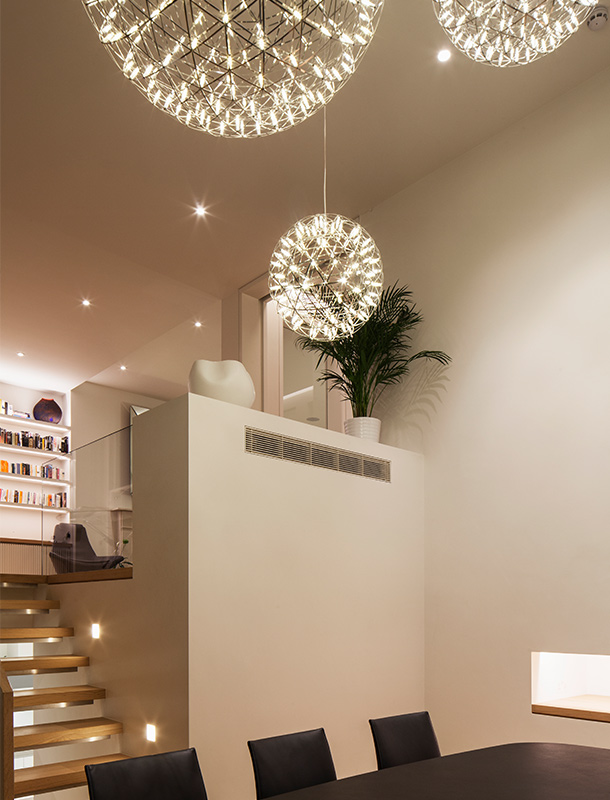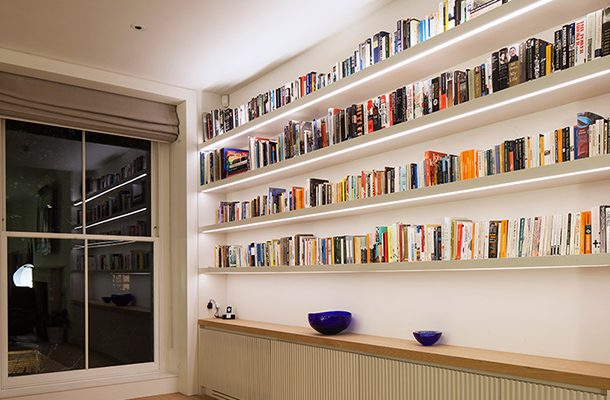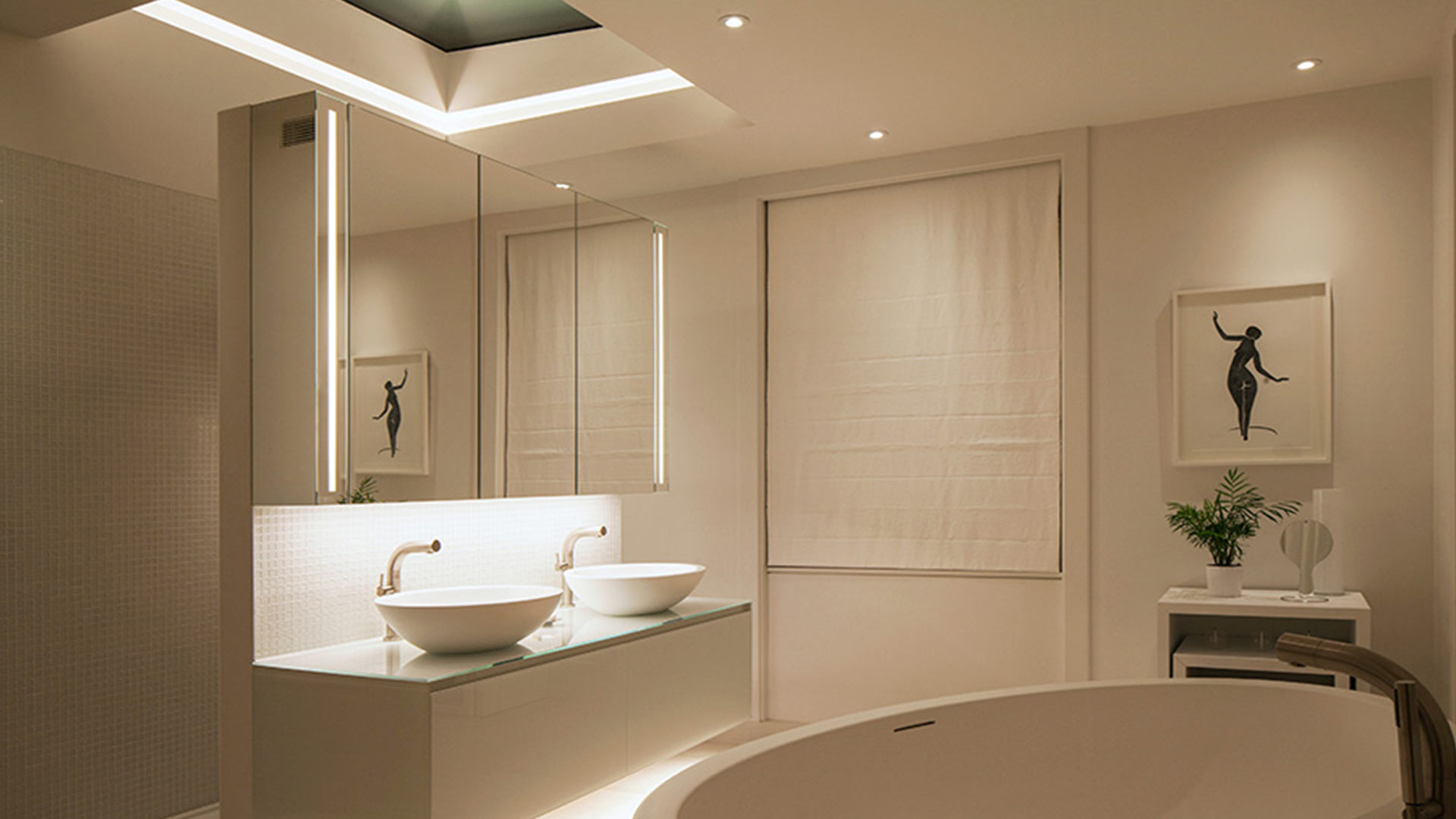Bedrooms, Bathrooms & More
Lighting is key to creating the right ambience in your home, but it doesn’t mean that you have to spend a fortune on designer light fittings. While you may want to splash out on a focal piece in a particular room or space, the key to great lighting is the quality of the light and how it’s being used.

If you’re renovating a property, you should think about the lighting right from the start. At the luxury end of the market in particular, it’s all about attention to detail, where lighting should be integrated into joinery, architectural details and mirrors, rather than stuck on at the end. This will provide a more sophisticated and cost effective solution.
Firstly, consider how you use each space; the light levels you need for particular tasks and the type of ambience you’d like to create at different times of day. To create ambience and interest in a space, you need separate layers of light, and contrast between higher and lower light levels. When we’re designing a scheme, we split the lighting down into three fundamental layers:
Ambient Lighting: this provides a general base level of functional light.
Accent Lighting: this highlights key features and details within a space. Think carefully about where the lights are positioned – they should each be focused on a specific task. For example, downlights positioned over taps in a bathroom will provide sparkle and washing walls with light can help make a small space appear larger, while still providing good ambient lighting.
Feature Lighting: such as shelf and niche lighting that adds detail to a space. Decorative pendants, table and floor lamps provide an opportunity to add character. A neutral palette using high quality finishes and materials – to add texture and interest – is a popular interior design approach, and using lighting to express these finishes can really maximise their impact.

To avoid a ceiling peppered with downlights, start building up your layers with accent and feature lighting first, and then add in downlights only where needed.
In the bedroom, bedside lights can be wall-mounted or even suspended, particularly if there’s not much space, but table lamps provide the most flexibility and don’t require a professional to install. They also allow you to have a bit of fun and enhance the décor – but don’t forget that they serve an important function as well.
When selecting lamps make sure you see them turned on and look at how the light is emitted: is it all directed down (great for task lighting) or is it thrown out 360 degrees (great for brightening a dark corner). And when it comes to lampshades, beware. The colour / finish may match your sofa, but how much light do they give out and do they affect the colour of the light.
It’s also important to spend money on your light sources – good quality LED light bulbs will provide a great quality of light, reduce maintenance and energy costs. You can transform a space just by selecting the right light source. However, with all the new LED and other energy-saving light bulbs on offer choosing the right one has never been more complicated. In brief, the rules are as follows:
Always buy light bulbs from reputable manufacturers. They might be more expensive but they will last longer, give you a better quality of light and avoid any safety concerns. The wattage is no longer a clear indicator of the amount of light that a light bulb will emit – you now need to look at the lumen output. As a rough guide, old watts to new lumens goes like this: 25W = 200-300lm / 40W = 400-500lm / 60W = 700-800lm / 100W = 1300-1400lm.
“Colour temperature” is what indicates how warm or cold a light source will be – the lower the number the warmer the light. Candlelight is around 1500K, the old incandescent bulbs are between 2250-2700K, tungsten halogen 3000K, cool white is at 4000K (often used in offices) and 6500K is a cold light similar to daylight. In general, residential lighting uses between 2500- 3000K, and while you can mix them for effect, it’s normally best to stick with one colour temperature throughout.
In bathrooms an important element to get right is mirror lighting. The key to flattering light is to use a diffuse light source and to make sure the light falls evenly between your face and the mirror. There are a number of approaches you can take:
A couple of carefully positioned downlights can work but make sure they’re positioned between the front of your face and the mirror, to avoid shadowing.
Wall lights either side of the mirror or one above will also work, but make sure that they have a diffuse shade on them to provide a soft light.
Many mirrors come with integral lighting that’s positioned behind frosted sections of the mirror, and these can provide an excellent solution.
If you don’t like the aesthetic of integrated mirror lighting then you could look at halo lighting the mirror by mounting it slightly off the wall and positioning some LED tape behind it, so that the light washes out from the back. Just make sure the tape is positioned far enough in so that you can’t see it.
When selecting the light source, try to get one with high colour rendering for the most flattering and true light: CRI 90> is best.
Other areas to consider are lighting inside of wardrobes, under kitchen cabinets and night lighting for bathrooms – a presence detector can easily switch these on and off as required.
In today’s world of open plan / dual-purpose spaces flexibility is essential. By putting each layer of lighting on a separate lighting circuit / switch, it allows you to create different scenes and ambiences to meet all your needs. And ideally lighting should be dimmable. You could consider introducing a lighting control system but keep it simple and in line with your requirements – if you only have two lighting circuits in a space then it’s probably overkill.
At the end of the day have fun, grab a lamp and start playing with different lighting options. Lighting can completely change the look and feel of a space, at the flick of a switch – literally.
Images: © James French


